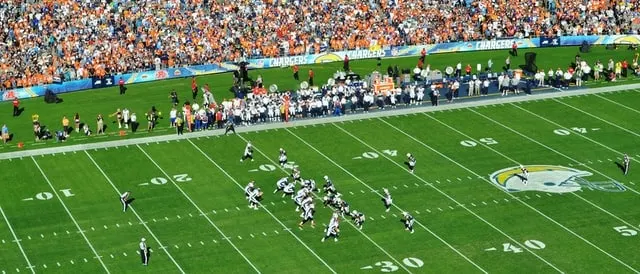
\In fantasy football, you may be wondering about trades made by your NFL team because you feel like you could do a better job if you were the general manager. That’s where the beauty of fantasy football comes in—you can become the general manager and show your skills at improving your roster through trading. You’re deciding who to start every week, and you’re also making other big decisions to hopefully come out on top during the fantasy season.
Trading starts once the season gets underway, and owners have started to figure out what they like and dislike in their rosters.
As a note, the trading discussed below applies primarily to re-draft leagues. If you’re part of a dynasty or keeper league, your trading strategies are going to be at least somewhat different.
1. The Basics
In fantasy football, a trade is a type of transaction. In this transaction, two teams designate certain players and then swap them. A trade can actually happen before, as well as during, or after a draft, based on what type of league you’re in.
In keeper and dynasty leagues, your draft picks can be something you use as trade compensation.
The rules are similar to the trading rules of the actual NFL. In the NFL, it’s common for teams to trade players throughout the season.
The goal of any trade in fantasy football is to secure a player who’s going to help your team but not have to give up someone who’s benefitting you. A trade if both parties are competent at fantasy isn’t going to be much more than marginally better.
However, if you trade players that play different positions, you might be able to start a player another team doesn’t use.
2. The Rules
Depending on your league rules, there may be some review restrictions that determine how fast a trade can be processed. If there aren’t any review rules in a league, trades will be approved when they’re accepted by the second manager.
If a league does use a commissioner review process to avoid cheating and collusion, the trades may take as long as 48 hours to go through review.
3. Strategies
In fantasy football, there might be some different strategies you use in trading. Trading is a gamble, and there are going to be both wins and losses that can come along with it. There may be times when you come out of a trade with more wins, and other times, you might make an unproductive trade that you regret.
One strategy to keep in mind is trading from an advantage. You want to trade from your strongest position.
For example, let’s say you have several good running backs, but your quarterback is weak. Maybe you pick one of your strong running backs and use him as a way to convince the other owner to trade you a strong quarterback. Then, you can balance your team.
Another strategy to think about is the combo trade.
You might want to get another owner’s interest by offering them more than a single player as part of a deal. Maybe another owner has a player that you have a real belief in—you could, in that position, decide to offer two pretty good players for that one player you see as being a star. The goal is trading two average players for one who’s excellent.
There are also trade calculators online to help with projections and comparisons, so you’ll get a better idea of how a trade might work out.
When you’re trading, don’t think about your personal favorites. You don’t want to make a trade just to get someone you favor on your team. That’s not how fantasy works. Depending on the performance of the player, no matter how much you love them, having them on your team may be a mistake.
You have to trade based on stats above all else.
Trading can be somewhat like a business, too. Make sure you’re diplomatic as you’re working with other owners. You want to sweeten deals enough so that people want to work with you, and you also want to build relationships so that, going forward, other owners are willing to make trades with you.
4. The Trade Deadline
The trade deadline is the last day of the season when a trade can be processed—it’s usually during week 12 or 13 of the NFL season. That makes sure all the teams that are eliminated from potentially heading to the playoffs can’t trade their strong players to teams that are going to the playoffs to increase their chances.
Your individual league will decide whether or not to have a trade deadline.
5. Types of Trades
Above, we talked about some of the potential trade strategies—there are also some basic trade types that are similar overall.
One is to exchange a position of need. This is the most common trade in fantasy, and it’s usually a one-for-one deal. As mentioned above, if you have a player who has a surplus of talent in one position, they might want to strengthen whatever their weak position is. This is a win-win for both teams, making it a classic type of trade.
Another, which was briefly talked about above and is a type and a strategy is where you’re trading multiple players. These aren’t as balanced as a position of need trade. You might be trying to trade two reserve players for one starting player. One team might be focusing on quantity instead of quality if they’re dealing with injuries, as an example of when this could work.
A fill-in trade is when you’re just trying to cover for a brief period of time—usually no longer than a week or two. You might make this trade to cover the bye weeks or maybe an injury. You could be trading a player who you don’t typically start for one that another owner also doesn’t usually start.
If you’re going to trade, start by evaluating your roster. Look at your strengths and weaknesses, and consider whether you’re very weak at any position and whether you have a surplus at any position.
Finally, before trading, ask yourself if you could address weaknesses with the waiver wire.
- Sagittarius Man & Gemini Woman Love and Sex Compatibility - January 31, 2024
- Taurus Ascendant Rising Personality Traits in Men (Guide) - January 31, 2024
- How to Seduce and Attract a Sagittarius Man (Seduction Tips) - January 31, 2024
